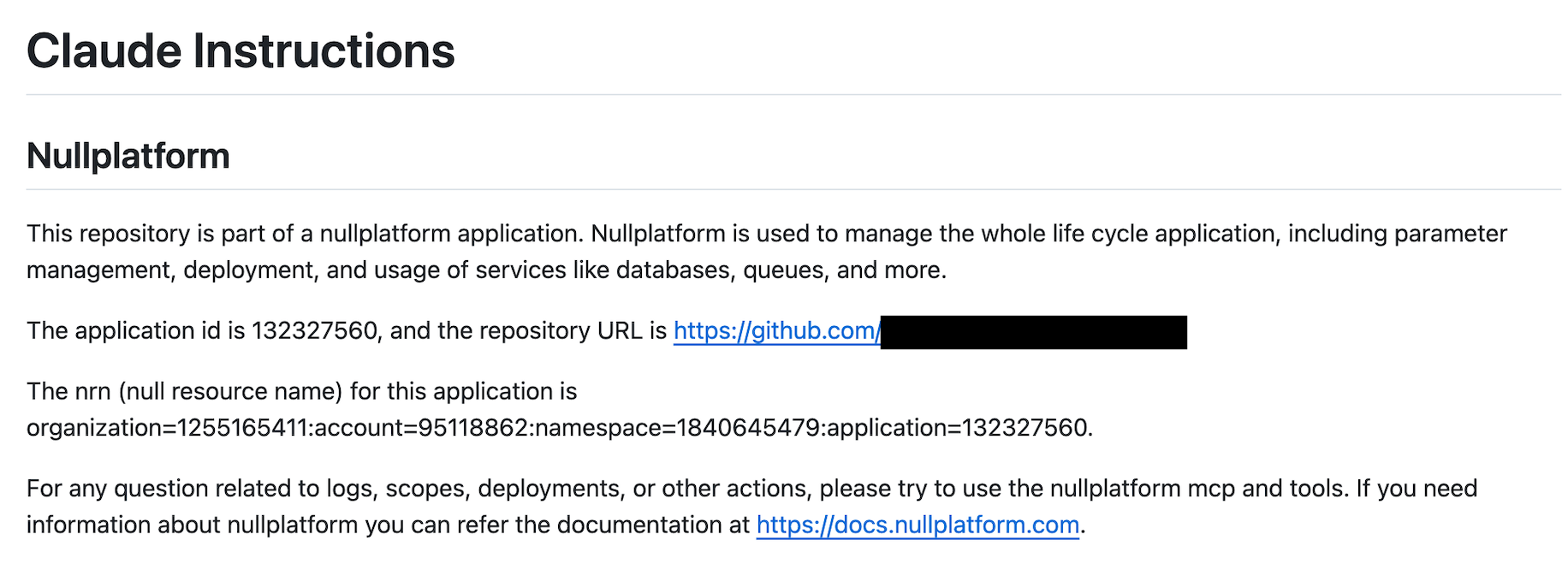Automatically update application repositories on creation
🎯 Goal: Automatically update application repositories with custom files or changes when new applications are created.
Introduction
When creating a new application, you might want to add extra files that make the repository more useful from the start. These could include documentation, configuration, or metadata that other tools can leverage later.
In this guide, we’ll show how to automatically add a CLAUDE.md file to the application repository.
This file gives Claude Code additional context about your application’s data, helping you get the most out of the nullplatform MCP.
You’ll set this up using:
- Hooks to react to application creation events
- Notification channels to forward events to your agent
- Agent scripts to modify the repository
What you’ll set up
By the end of this guide, you’ll have:
- An after-hook that reacts to application creation
- A channel that forwards hook notifications to your agent
- An agent script that adds a
CLAUDE.mdfile to the repository


1. Create a hook for application creation
Hooks in nullplatform let you react to entity changes. Here we’ll create an “after” hook that triggers when an application is successfully created.
Run this command to create the hook:
np entity-hook action create
--body '{
"nrn": "<account nrn or namespace nrn>",
"entity": "application",
"action": "application:create",
"status": "active",
"when": "after",
"type": "hook",
"on": "create"
}'
2. Create a channel to send notifications
Once the hook is ready, we need a channel so nullplatform knows where to send notifications.
To create a channel, you’ll need an API key that:
- Is set at the
accountlevel - Has the
agentrole assigned
See Manage your API keys for details.
In this example, we’ll use a channel that forwards events to a nullplatform agent.
np notification channel create
--body '{
"nrn": "<account nrn or namespace nrn>",
"source": ["entity"],
"type": "agent",
"configuration": {
"api_key": "<apikey>",
"command": {
"data": {
"cmdline": "<base-path>/handle-entity-hooks.sh",
"environment": {
"NP_ACTION_CONTEXT": "${NOTIFICATION_CONTEXT}"
}
},
"type": "exec"
}
},
"status": "active",
"filters": {
"entity": { "$eq": "application" }
}
}'
3. Add the repository modification logic
Now that your hook and channel are configured, add the script that updates the repository.
In your agent repository (see Agent docs for reference), create a new file at: <base-path>/handle-entity-hooks.sh
#!/bin/bash -x
WORKING_DIRECTORY="$(dirname "$(realpath "$0")")"
cd "$WORKING_DIRECTORY" || exit 1
echo "Received $NP_ACTION_CONTEXT"
eval "$(np service-action export-action-data --format bash --bash-prefix HOOK)"
if [[ $HOOK_ENTITY == "application" ]]; then
export APPLICATION_ID=$(echo "$HOOK_NRN" | sed 's/.*application=\([0-9]*\).*/\1/')
eval "$(np application read --id $APPLICATION_ID --format bash --bash-prefix APPLICATION)"
if [[ "$HOOK_ON" == "create" ]]; then
APP_DIR="/tmp/$APPLICATION_ID"
mkdir -p "$APP_DIR"
git clone --depth 1 "$APPLICATION_REPOSITORY_URL" "$APP_DIR"
cd "$APP_DIR"
cat << EOF > CLAUDE.md
# Claude Instructions
## Nullplatform
This repository is part of a nullplatform application.
Nullplatform manages the whole application lifecycle: parameters, deployments, and services.
The application ID is $APPLICATION_ID, and the repository URL is $APPLICATION_REPOSITORY_URL.
The NRN (nullplatform resource name) for this application is $HOOK_NRN.
For logs, scopes, deployments, or other actions, use the nullplatform MCP and tools.
Docs: https://docs.nullplatform.com
EOF
git add CLAUDE.md
git commit -m "Add CLAUDE.md with application details"
git push origin main
echo "Application created hook processed successfully."
rm -fr "$APP_DIR"
else
echo "No action taken for this hook context."
fi
fi
Wrap-up 🎉
From now on, whenever you create a new application in nullplatform, a CLAUDE.md file will automatically be added to its repository with helpful preloaded information.
This not only gives Claude the right context but also shows how hooks and agents can streamline automation in nullplatform.
Related docs
Quick links to resources used in this guide: